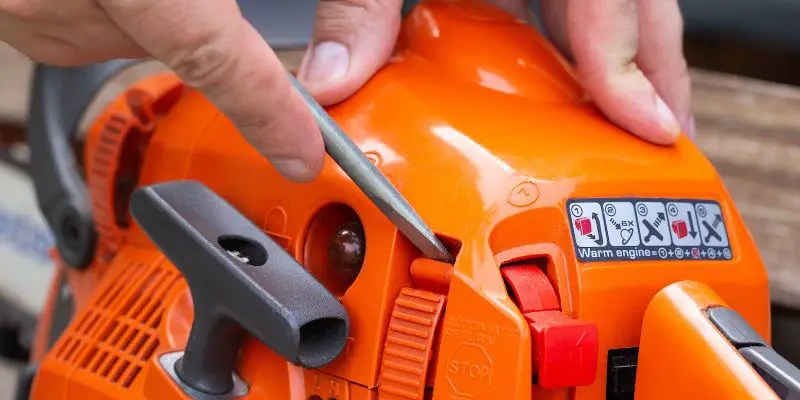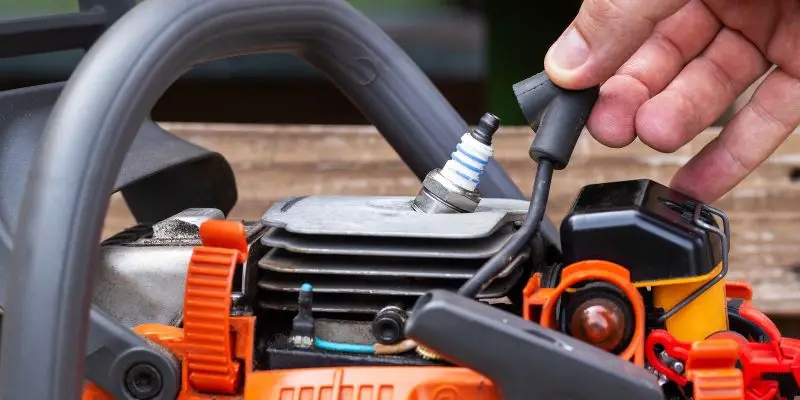To adjust a chainsaw carburetor, locate the three adjustment screws – the idle speed screw, the low speed screw, and the high-speed screw – and make adjustments using a screwdriver. A well-tuned chainsaw carburetor is crucial for optimal performance and fuel efficiency.
If your chainsaw is experiencing issues such as rough idling, stalling, or lack of power, it may be necessary to adjust the carburetor. This task, though it sounds daunting, can be easily done by following a few simple steps. In this guide, we will walk you through the process of adjusting your chainsaw carburetor, allowing you to keep your trusty tool running smoothly and effectively.
So, without further ado, let’s delve into the world of carburetors and master the art of adjustment.
Understanding Chainsaw Carburetors
A chainsaw carburetor is a vital component of the chainsaw’s engine that manages the fuel mixture required for optimal performance. Understanding how the carburetor works and why carburetor adjustment is important can help you ensure that your chainsaw operates at its best. In this article, we will delve into the basics of chainsaw carburetors, explore why carburetor adjustment is crucial, and provide you with a step-by-step guide on how to adjust a chainsaw carburetor.
What Is A Chainsaw Carburetor?
A chainsaw carburetor is a small, but powerful, device responsible for mixing the right amount of fuel and air before it enters the engine’s combustion chamber. This mixture is essential for the chainsaw’s combustion process, as it provides the necessary energy to power the engine and operate the chain. Without a properly functioning carburetor, a chainsaw may experience a range of issues, including difficulty starting, poor performance, and excessive fuel consumption.
Why Is Carburetor Adjustment Important?
Carburetor adjustment plays a crucial role in optimizing a chainsaw’s performance. When a chainsaw leaves the factory, its carburetor is typically set to work in general operating conditions. However, factors such as altitude, temperature, and fuel quality can affect the air-fuel mixture required for optimal performance. Therefore, adjusting the carburetor allows you to fine-tune the chainsaw’s fuel-air ratio to match these changing conditions.
By adjusting the carburetor, you can achieve a cleaner and more efficient combustion process, resulting in improved power output, smoother operation, and extended engine lifespan. Proper carburetor adjustment also helps prevent potential engine damage caused by running too lean or too rich, such as piston scoring, overheating, or excessive wear on engine components.
Regularly checking and adjusting the carburetor can also help mitigate common issues such as starting problems, stalling, idling irregularities, and chain bogging. By maintaining the carburetor’s optimal settings, you can ensure that your chainsaw delivers consistent performance and remains reliable throughout various cutting tasks.

Step-by-step Guide To Adjusting A Chainsaw Carburetor
Adjusting a chainsaw carburetor is an important skill for any chainsaw owner. Proper adjustment ensures smooth operation and optimal performance of your chainsaw, while also helping to extend its lifespan. In this step-by-step guide, we will walk you through the process of adjusting your chainsaw carburetor, from preparing for the adjustment to fine-tuning the carburetor mixture. By following these instructions, you can keep your chainsaw running smoothly and efficiently.
1. Preparing For Carburetor Adjustment
Before starting the carburetor adjustment process, it is crucial to take some preliminary steps to ensure a safe and efficient adjustment. Here’s what you need to do:
- Ensure the chainsaw is turned off and cool to the touch.
- Remove the air filter cover and clean or replace the air filter if necessary.
- Inspect the fuel filter and replace it if clogged or worn out.
- Check the spark plug condition and gap, cleaning or replacing it if needed.
- Make sure you have the necessary tools, including a carburetor adjustment tool.
2. Locating The Carburetor
Each chainsaw model may have a slightly different carburetor location, but most carburetors are typically found near the engine. To locate the carburetor on your chainsaw, follow these steps:
- Locate the engine cover on your chainsaw.
- Remove the engine cover to expose the engine components.
- In this area, you should be able to identify the carburetor, which is usually attached to the engine cylinder.
3. Adjusting The Low-speed Carburetor Screw
In order to adjust the low-speed carburetor screw, follow these steps:
- Start your chainsaw and let it warm up for a few minutes.
- Locate the low-speed carburetor screw, which is usually marked with an “L” or “LA”.
- Using a carburetor adjustment tool, turn the low-speed carburetor screw clockwise until it lightly seats. Then, turn the screw counterclockwise 1.5 turns as a starting point.
- With the chainsaw still running, slowly turn the low-speed carburetor screw counterclockwise until the engine runs smoothly and accelerates without hesitation.
4. Adjusting The High-speed Carburetor Screw
To adjust the high-speed carburetor screw, follow these steps:
- Run your chainsaw at full throttle for a few minutes to warm up the engine.
- Locate the high-speed carburetor screw, typically marked with an “H” or “HA”.
- Using the carburetor adjustment tool, turn the high-speed carburetor screw clockwise until it lightly seats. Then, turn the screw counterclockwise 1.5 turns as a starting point.
- While the chainsaw is still running at full throttle, gradually turn the high-speed carburetor screw counterclockwise until the engine reaches its maximum speed without sounding strained.
5. Fine-tuning The Carburetor Mixture
After adjusting the low-speed and high-speed carburetor screws, you may need to fine-tune the carburetor mixture. Here’s how:
- Idling your chainsaw, locate the idle speed screw, often marked with “T” or “TA”.
- Using the carburetor adjustment tool, turn the idle speed screw clockwise to increase RPM or counterclockwise to decrease RPM until the chainsaw idles smoothly.
- If necessary, adjust the low-speed and high-speed carburetor screws slightly to optimize the idle speed and acceleration response.
By following this step-by-step guide, you can adjust your chainsaw carburetor with confidence. Remember, regular carburetor maintenance and adjustment are crucial for ensuring top performance and a long lifespan for your chainsaw.
Troubleshooting Chainsaw Carburetor Issues
When it comes to the proper functioning of your chainsaw, the carburetor plays a crucial role. It is responsible for the mixture of fuel and air that powers the engine. However, over time, the carburetor may start to experience issues that can affect the performance of your chainsaw. In this section, we will discuss common carburetor problems, understanding carburetor symptoms, and troubleshooting techniques to help you adjust your chainsaw carburetor and keep your tool running smoothly.
Common Carburetor Problems
- Clogged fuel jets
- Improper idle speed
- Rich or lean mixture
- Fuel leakage
These problems can lead to performance issues, such as difficulty starting the chainsaw, inconsistent idle speed, poor acceleration, or excessive fuel consumption. Understanding these common carburetor problems will help you diagnose and fix them effectively.
Understanding Carburetor Symptoms
Before you start troubleshooting the carburetor, it’s important to be familiar with the symptoms that indicate an issue. Here are some common symptoms:
- Difficult starting or failure to start
- Inconsistent or unstable idle speed
- Lack of power during operation
- Excessive smoke or fouled spark plugs
- Stalling or sputtering during acceleration
By recognizing these symptoms, you can determine if the carburetor is the culprit and proceed with the necessary adjustments.
Troubleshooting Techniques
Now that you have identified the common carburetor problems and the associated symptoms, let’s discuss some effective troubleshooting techniques:
- Inspect and clean the carburetor: Remove the carburetor from the chainsaw and visually inspect it for any signs of dirt, debris, or clogs. Clean the carburetor using an appropriate carburetor cleaner and a small brush.
- Adjust the idle and mixture screws: Use a small screwdriver to adjust the idle and mixture screws on the carburetor. Turning these screws clockwise will lean the mixture, while turning them counterclockwise will enrich the mixture. Make small adjustments and test the chainsaw’s performance after each adjustment.
- Check the fuel filter and lines: Inspect the fuel filter and lines for any blockages or damage. Replace any faulty components to ensure a consistent fuel supply to the carburetor.
- Verify the air filter: A clogged air filter can restrict airflow and affect the carburetor’s performance. Clean or replace the air filter as needed.
- Consult the chainsaw manual: If the troubleshooting techniques mentioned above do not resolve the issue, refer to the chainsaw’s manual for specific instructions on adjusting the carburetor. The manual will provide guidance on the appropriate settings and procedures for your particular chainsaw model.
By following these troubleshooting techniques, you can effectively adjust your chainsaw carburetor and restore its optimal performance. Regular maintenance and periodic inspections will help prevent carburetor issues and ensure your chainsaw continues to operate smoothly.

Frequently Asked Questions Of How To Adjust A Chainsaw Carburetor
What Are The L And H Adjustments On A Chainsaw?
The L adjustment on a chainsaw is for adjusting the low-speed fuel mixture, while the H adjustment is for adjusting the high-speed fuel mixture. These adjustments help optimize the chainsaw’s performance and ensure it runs smoothly.
What Are The Adjustment Screws On A Chainsaw Carburetor?
The adjustment screws on a chainsaw carburetor are used to regulate the air-fuel mixture. They control the amount of fuel and air entering the engine, which affects its performance. There are usually two screws: the idle adjustment screw and the high-speed adjustment screw.
By turning these screws, you can fine-tune the chainsaw’s operation.
How Do You Adjust A 2 Stroke Carburetor?
To adjust a 2-stroke carburetor, follow these steps for optimal performance:
1. Locate the adjustment screws.
2. Warm up the engine.
3. Adjust the idle screw to set the idle speed.
4. Adjust the high-speed screw to fine-tune the upper RPM range.
5. Rev the engine a few times and make further adjustments if needed.
How Do You Adjust The Gas Flow On A Carburetor?
To adjust the gas flow on a carburetor, locate the carburetor adjustment screws. Turning them clockwise will increase the gas flow, while turning them counterclockwise will decrease it. Be careful not to over-adjust and consult the owner’s manual for precise instructions.
Conclusion
Adjusting a chainsaw carburetor is crucial in ensuring optimal performance. By following the steps outlined in this guide, you can easily make the necessary adjustments to keep your chainsaw running smoothly. Properly adjusting the carburetor will not only improve fuel efficiency but also extend the lifespan of your chainsaw.
Remember to take your time and refer to the manufacturer’s instructions for specific details. With regular carburetor adjustments, you’ll be able to tackle any cutting task with ease.


